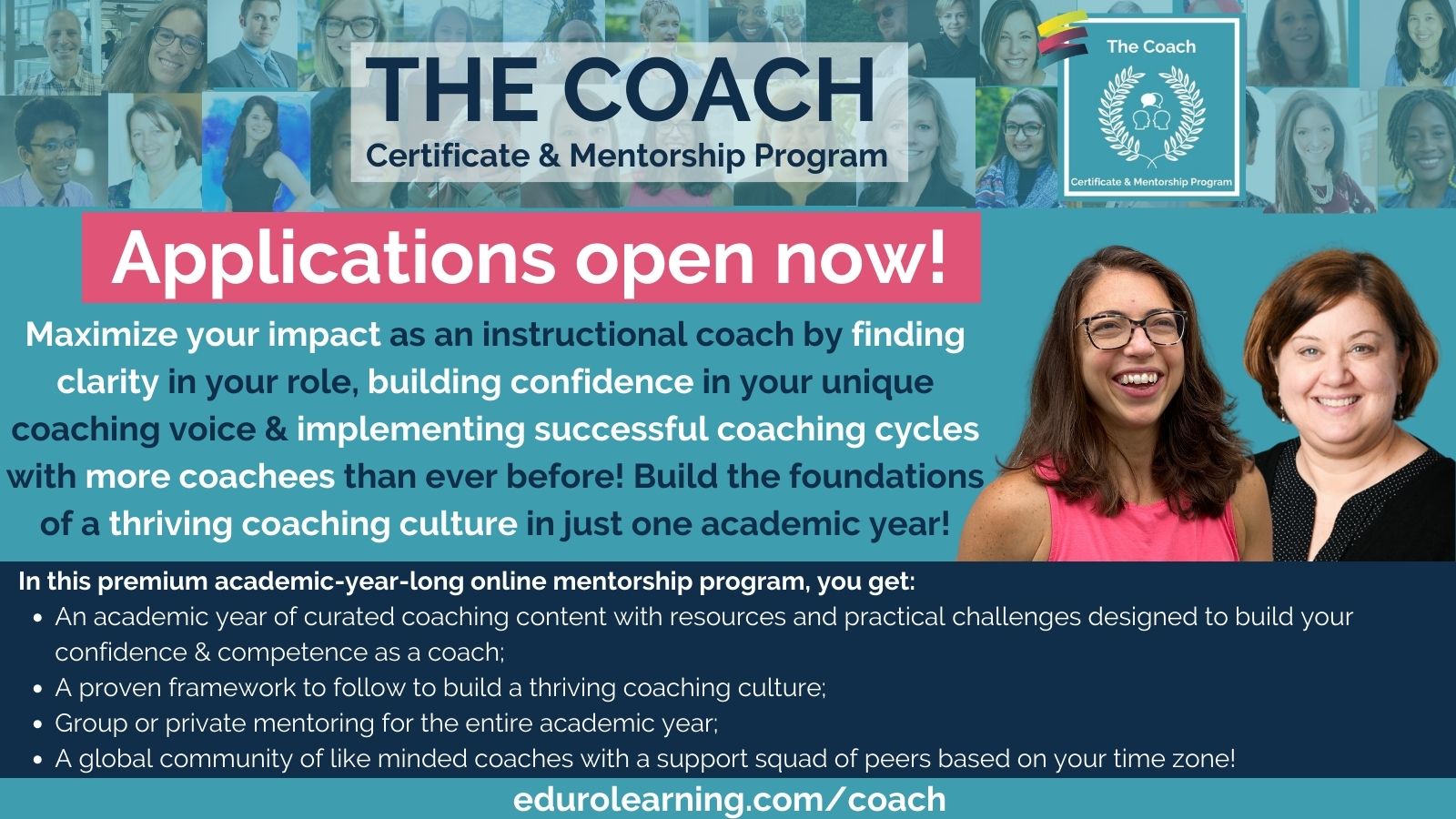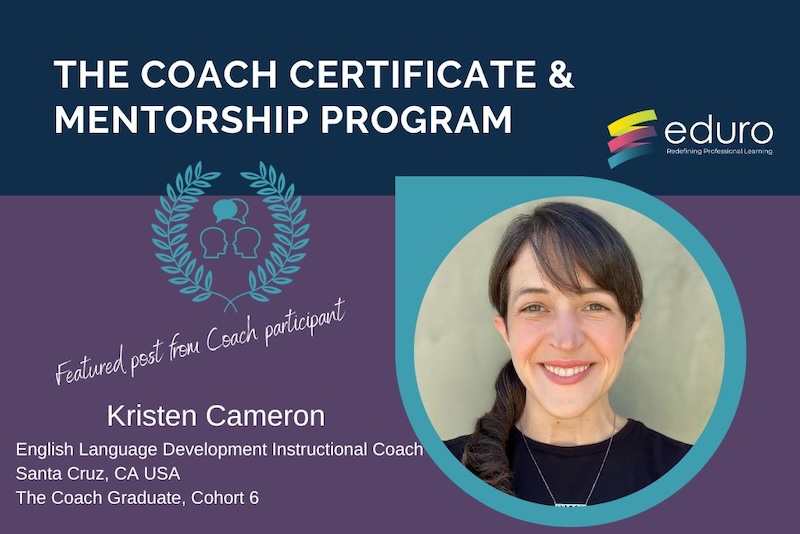We want to give you a peek inside our Coach Certificate & Mentorship Program. Coaches taking part in this academic-year-long journey have graciously given us permission to post some of their learning and reflections from the private coursework they are undertaking during this program. Where possible, we have shared the course and the action task to give context for the guest post.
The Topic: Phase 1: Find Clarity
The Task: Share your artifact and a written reflection on your learning during this phase.
Here are my 4 key “aha” moments from Phase 1: Finding Clarity –
- Discomfort often propels us into our greatest learning and/or gains. When we are gently pushed into our discomfort, this is when we have some of our greatest opportunities for learning and growth. This discomfort should come from gentle questioning that creates enough dissonance for us to want to examine our practice and look for opportunities for growth, rather than from judgment or criticism or evaluation. To me this has immense implications as to the value of formal evaluation and as to how leaders should approach evaluation cycles. If we don’t create dissonance in a supportive, safe way, how can we possibly expect teachers to feel comfortable taking the kinds of risks that can truly transform student outcomes?
- The impact of coaching should be measured by keeping students at the center. Lead indicators include: student outcomes improving and showing progress; students feeling more successful; teachers reporting that they are gaining knowledge and skills and the support needed to put them into practice; coaches focused on topics that are directly related to identified needs for students; coaches doing high leverage work (e.g. coaching cycles); and the culture of collaboration at sites (e.g. there is peer observation, more openness to talk about practice, and more willingness to ask for help).
- Jim Knight’s Partnership Principles – I want to keep a copy of them in my physical toolkit at all times because I think they read like the kind of collaborative norms I want to establish at every meeting I attend.
- PEERS goals – There is just something about the PEERS goal words that I think helps a teacher (or coach) focus on students and growth versus a timeline and ticking a box for admin or HR. I think the PEERS goals frame can help establish a growth mindset and a sense of connection and value to the work of growing as a professional educator.
Here are the obstacles I faced during this phase of the program and how I am working to and/or plan to overcome them –
- Scheduling – how should Santa Cruz City Schools instructional coaches spend their time? I am continuing to grapple with where I work, how I work, who I work with and what the majority of my time is spent doing. For the bulk of the months of August and September, I have been a curriculum specialist and a creator and facilitator of one-off professional development sessions. But… The most impactful work I’ve done over the past two months has been coaching individuals and teams: this continues to be where I see impact on teacher practice and student learning outcomes.
- Time and structures for collaboration – I view this as a potential opportunity for coaching up and definitely as an area for growth in my district because right now many of our professional learning communities are not very vibrant. What I hear from teachers is that they have been given too many things to focus on and not enough voice and choice for significant professional learning and growth to occur. Many teachers and teams have shared that they see administration and leadership as being overly concerned with accountability: teachers feel that admin are more concerned about knowing that everyone is in a meeting, rather than that a meeting has been appropriately differentiated to meet the needs of all of the adult learners in the room. Having worked in the district for many years now, I find myself agreeing with the sentiments of the teachers and so, as a coach, I want to look for opportunities to converse with administrators in an effort to gain a better understanding of where they are coming from and why things are the way they are.
The artifacts I created and am sharing for this module are:
I chose to create these artifacts because they feel relevant and useful to my coaching practice. Here is a bit more about each one –
- The vision card is a tool for communication with others, and it is in alignment with my core values and the district’s mission and vision. It is also a great reminder for me and helpful for keeping my ‘why’ at the center of my day-to-day.
- The coaching menu is a great conversation starter for a first meeting with a team or individual (note: the plan is to replace the weird sihlouettes with actual pictures of SCCS instructional coaches). It has also been a great document to share with district administrators and a tool for me to use for collecting data about teachers needs and wants. By showing that teachers continue to gravitate toward menu items like ___ and ___, I can continue to build a case with my administrators for more coaching cycles and more instructional coaches.
- The color-coded calendar has been a game-changer. I decided to do this after listening to Kristen Moreland’s episode of the Coach Better podcast, “The Work You Do As An Instructional Coach Matters! Here’s How to Share It!” – and I actually got it done after it came up again during office hours with Marcie, Jessica and Diana. This simple move has given me instant, highly-visual insight into how I am spending my time and if it squares with how I would like to be spending my time. It’s also serving as a great way to collect data to use for initiating conversations with site administration, district leadership, the school board, union leaders, etc.
What did you learn in the creation of this artifact?
- I think what has resonated with me most, and I’ve heard Kim say this in several Coach Better podcast episodes; I’ve heard Diana say it in mentoring meetings; and I’ve heard professionals like Angela Harkness and Lindsay Deacon say it as well: it is my responsibility to clarify my role and coach up to administrators and leadership about what I am doing and why. I need to take the initiative to advocate for exactly what I should be doing and why it will be the most impactful way for coaching to move forward in our district.
How has this artifact moved you closer to clarity in your coaching role or program?
- I feel like these artifacts are all tools that will help me shine a light on the current reality of coaching in my district as well as on what research says best–most impactful–practice would look like. Having a more clearly defined plan for how to get there feels empowering. I feel like I know where I want to go, and I have a good idea of how I want to get there. I also feel like my passion and vision are in alignment with what my administrators and leaders want, and so the job now is to show them a clear path for how to get there and what indicators will help us see our progress. I feel like I’m writing Learning Goals and Success Criteria for developing a coaching program for the district
Next steps for me include:
- Finding teachers who will commit to engaging in a series of coaching cycles with me over the next few months and collecting loads of evidence/documentation/etc. while engaging in these cycles.
- Continuing to refine my color coding and labeling of events in my calendar to enhance clarity. I am also thinking about using hashtags to add a level of detail.
- Continuing to draft and refine a coaching up document (I’m thinking an info graphic followed with excerpts from research) to use with administrators and leadership for making my case for what my job should look like and why. Preparing for a conversation and/or even a presentation to leadership (and the union).
Read more from The Coach participants as they share their learning from the certificate & mentorship program…
Kelly: Math Coaching Menu
Tracy: Coaching Menu
Ian: Navigating Teacher Buy-in For Instructional Coaching
Kate: Reflecting on a Post Observation Conversation
Level Up Your Coaching with The Coach!
If you are ready to dive deep into your coaching practice, to help you #coachbetter and build a thriving coaching culture in your school, please join us for our next cohort of The Coach!
Wherever you are in building a coaching culture in your school, The Coach will give you the strategies, skills and tools you need to make coaching a success and will empower you to confidently apply instructional coaching strategies in any situation – from building a coaching program, to having coaching conversations, to being a leader in your school community. We facilitate only one cohort each academic year so we can offer individualized support for each participant.
Coaches of all levels are welcome: you’ll start the program with a self-assessment to determine exactly what the next steps are for you!


Recent Comments